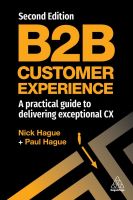
Great customer experience is a fundamental requirement of every business. Get it right and you’ll see increased customer loyalty and drive revenue growth.
There are, however, instances where designing a great customer experience may not immediately translate into visible dividends.
For example, a well-thought-out customer experience initiative may fail in its execution if frontline employees are not adequately trained or by setting unrealistic expectations that can’t be delivered.
Maintaining consistency across multiple touch points and channels can also prove a challenge. Excelling in one channel but falling short in another can lead to a fragmented and disjointed experience for customers.
To help you build successful and profitable customer experiences while avoiding common pitfalls such as those above, here are 3 things you’ll need to think about:
1. Understanding customer needs
Investing heavily in delivering what a company believes to be an outstanding customer experience is no guarantee of success. Without the same level of investment in understanding their customers’ needs prior to designing the experience, it may fail to resonate or meet the expectations and desired outcomes of customers.
Blockbuster is of course a well-known example of what happens when a company fails to recognize shifts in customer behavior. As technology advanced and online streaming and digital downloads became the norm, Blockbuster maintained its emphasis on physical rental stores and ultimately went bust. Netflix meanwhile, a DVD-by-mail rental service at the time, introduced a subscription-based model allowing customers to rent DVDs online before later transitioning into the hugely popular streaming service it is today.
We must also remember that needs and expectations change during the customer journey. A new customer going through the on-boarding process will appreciate a good deal of handholding, while an established customer may be looking for more specific help in maintaining their competitive advantage. Customer experience is not great if it is delivered to a point on the customer journey from which the customer has moved.
2. Consistency and patience
Building customer loyalty and reaping the rewards of exceptional customer experience requires consistent efforts and a long-term perspective. It’s not uncommon for business leaders to lose interest in their customer experience initiative if they did not see immediate returns or believe they had finished that “project” and moved on to other things. A fall in profits can also lead to companies cutting investment in customer experience – a strategy which often leads to disaster.
Maintaining consistently great customer experience across every touchpoint in the journey is also crucial to success. Gaps or inconsistencies across certain touchpoints may undermine the positive impact across others and negatively impact satisfaction and loyalty, and ultimately, revenues and profits.
Delivering great customer experience requires every department to be aligned and work seamlessly together. A lack of coordination or working in internal silos can hinder the implementation of customer experience initiatives and result in an inconsistent or frustrating experience for customers.
3. External factors
Even if a company excels in delivering great customer experience, external factors may override the immediate impact and delay the expected returns.
For example, customers may be swayed by other factors. Ryanair’s low cost and broad flight availability draws many customers who are prepared to sacrifice the higher level of customer experience of a high-priced legacy airline. Although Ryanair has begun to recognize the importance of treating customers with more care if they want to avoid losing business to competitors such as EasyJet. Airlines who offer both good value and great customer experience, such as Southwest Airlines in the US, are well placed to succeed.
Changing consumer trends and economic uncertainty may also influence customer behavior and purchasing decisions. Borders, a prominent bookstore chain in the US, was loved by book lovers who appreciated its extensive selection of books, ambience and helpful staff. But with the rise of ecommerce and digital books, online retailers such as Amazon were able to steal market share and deal a significant blow to traditional bricks-and-mortar bookstores such as Borders. The 2008 global financial crisis further added to Borders’ troubles as reduced customer spending led to a decline to book purchases.
B2B Customer Experience: A Practical Guide to Delivering Exceptional CX
As discussed above, delivering a great customer experience will inevitably lead to a growing base of loyal customers and increased revenue and profits. Yet companies need to be aware of the potential pitfalls to ensure the benefits of investing in great customer experience come to fruition.
These include investing in a customer experience that is misaligned with customer needs, or delivering a great experience at a point in the customer’s journey where it is no longer relevant. And sometimes, the competitive environment is so fierce that no amount of great customer experience can overcome external forces.

B2B Customer Experience: A Practical Guide to Delivering Exceptional CX, is a bestselling guide co-authored by Nick Hague, Head of Growth at B2B International, on how to bring customer excellence to B2B businesses to retain existing clients and win new business. If you’re interested in learning more about the contents of this latest book and how B2B International can assist your company in delivering a more profitable customer experience, please get in touch with our research team.


